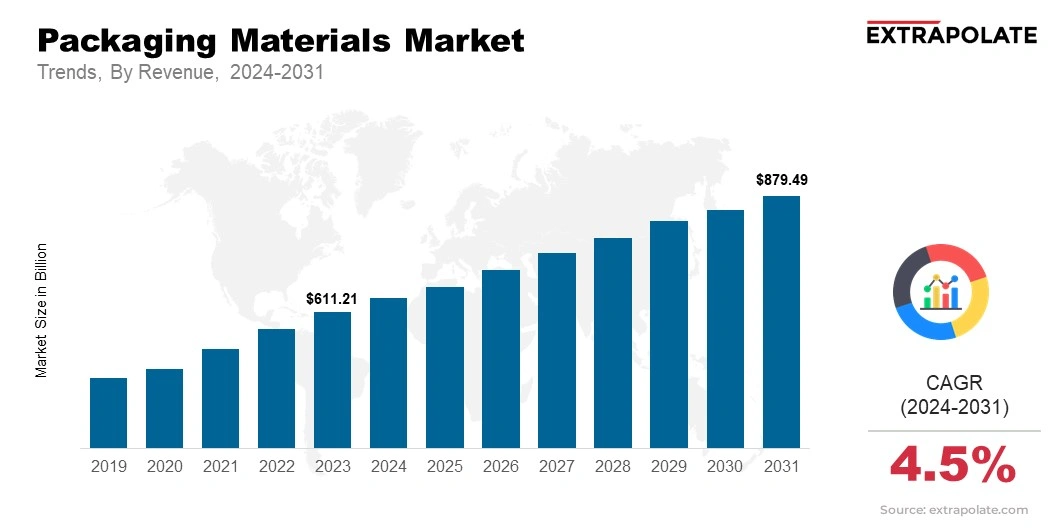Packaging Materials Market Size, Share, Growth & Industry Analysis, By Material Type (Plastics, Metals, Glass, Paper, Biodegradable Materials), By Application (Food & Beverages, Healthcare, Personal Care, Industrial, Others), By End User (Consumer Goods, Pharmaceuticals, Automotive, Retail, Ecommerce), and Regional Analysis, 2024-2031
Packaging Materials Market: Global Share and Growth Trajectory
Global Packaging Materials Market size was recorded at USD 611.21 billion in 2023, which is estimated to be valued at USD 644.36 billion in 2024 and reach USD 879.49 billion by 2031, growing at a CAGR of 4.5% during the forecast period.
The global market is growing quickly. This is fueled by the demand for sustainable solutions, industrial growth, and the rise of e-commerce. The market includes many types of materials. These range from plastics, metals, and glass to paper and biodegradable options.
Advancements in technology and growing consumer awareness are changing packaging materials. They now play a crucial role in product safety, branding, and sustainability.

Key Market Trends Driving Material Adoption
The packaging materials market is always changing. It is propelled by innovation, environmental rules, and shifting consumer expectations. Major trends driving market growth include:
- Sustainability Focus: There is more focus on biodegradable, recyclable, and reusable materials. Industries are working to reduce their environmental impact.
- Customization and Branding: Packaging designs are now customized to boost brand identity. They attract customers and make packaging an important marketing tool.
- Advanced Barrier Properties: Improved material technologies are offering better protection. They keep out moisture, air, and contaminants, ensuring product freshness and safety.
- Lightweight Solutions: Lightweight packaging materials are becoming more popular. This is reducing shipping costs and carbon footprints.
- Smart Packaging: Technologies like QR codes, NFC tags, and temperature-sensitive indicators are being integrated. This is presenting innovative Potential.
Major Players and Competitive Dynamics
The packaging materials market is highly competitive, with key players such as Amcor, Mondi Group, Ball Corporation, and Crown Holdings leading the charge. Smaller players are also entering the market with niche products and innovative solutions.
Consumer Behavior Analysis
Consumers are increasingly favoring packaging materials that align with their values, such as:
- Eco-Friendliness: Preference for biodegradable and recyclable packaging.
- Convenience: Materials that enable easy handling, opening, and disposal.
- Aesthetics: Visually appealing and functional designs that enhance product value.
- Product Safety: Packaging that ensures hygiene and product integrity.
Pricing Trends
Pricing trends in packaging materials vary. They depend on the type, quality, and application of the product. Sustainable and innovative materials often have higher prices. Traditional materials, like paper and basic plastics, are more affordable for mass-market use.
Growth Factors
Several factors are driving the growth of the packaging materials market:
- Rise in E-Commerce: Online shopping is growing rapidly. This increases the need for packaging. Consumers want packaging that is both durable and lightweight.
- Environmental Regulations: Stricter laws are encouraging manufacturers to adopt sustainable solutions. This is pushing the industry towards eco-friendly practices.
- Food Safety Concerns: High-quality materials are needed to preserve food and beverage products.
- Urbanization and Industrialization: Expanding urban populations and industrial activities are increasing packaging needs.
Recent Developments and Market Highlights
The market is rapidly evolving, with recent innovations including:
- Biodegradable Materials: Creating plant-based and compostable materials.
- Enhanced Recycling Technologies: Streamlining how plastics and other materials are recycled.
- Innovative Designs: Versatile and resealable packaging options becoming more widespread.
- Smart and Intelligent Features: Temperature-sensitive materials and interactive packaging solutions.
Current and Potential Growth Implications
a. Demand-Supply Analysis
The demand for packaging materials is seeing an increase. Nonetheless, scarcity of raw material and supply chain bottlenecks may affect the market.
b. Gap Analysis
Despite significant advancements, areas for improvement include:
- Using fewer materials that can't be recycled.
- Building more places to recycle materials.
- Enhancing cost-effectiveness of sustainable options.
Top Companies in the Packaging Materials Market
- Amcor
- Mondi Group
- Ball Corporation
- Crown Holdings
- Tetra Pak
- DS Smith
- Sealed Air Corporation
- Flexpak Services
- Amerplast
- International Paper
Packaging Materials Market: Report Snapshot
Segmentation | Details |
By Material Type | Plastics, Metals, Glass, Paper, Biodegradable Materials |
By Application | Food & Beverages, Healthcare, Personal Care, Industrial, Others |
By End User | Consumer Goods, Pharmaceuticals, Automotive, Retail, Ecommerce |
By Region | North America, Europe, Asia-Pacific, Middle East & Africa, South America |
High-Growth Segments
The following segments are projected to witness substantial growth:
- Biodegradable Materials: Addressing environmental concerns.
- Flexible Packaging: Lightweight and versatile solutions.
- Smart Packaging: Integrating technology for enhanced user experience.
Major Innovations
Innovation remains pivotal to staying competitive in the packaging materials market. Recent breakthroughs include:
- Advanced coatings for enhanced barrier properties.
- Smart materials for interactive and connected packaging.
- Development of bio packaging.
Potential Growth Opportunities
Corporations in the market meet a range of challenges:
- Balancing cost and sustainability.
- Meeting stringent environmental regulations.
- Adapting to technological breakthroughs in manufacturing processes.
- Surmounting logistical difficulties in the global supply chain.
Extrapolate Research says:
The packaging materials industry is seeing immense growth. This is because industries are adopting sustainability and innovation. Companies that adjust to changing consumer demands is expected do well. Meeting regulatory requirements and adopting technological shifts will help them progress.
ARE YOU SEEKING COMPREHENSIVE INSIGHT ON VARIOUS
MARKETS?
CONTACT OUR EXPERTS TODAY

Packaging Materials Market Size
- February-2025
- 148
- Global
- chemicals-and-advanced-materials
Related Research
Carbohydrases Market Size, Share & Trends Analysis Report By Application (Food and beverages, Anima
January-2021
1,2,3,4-Tetrahydroquinaldine Reagent (CAS 1780-19-4) -Global Market Status & Trend Report 2022-2030
August-2021
1,2,3,4-Tetrahydroquinaldine Reagent (CAS 1780-19-4) -Global Market Status and Trend Report 2022-203
August-2021
1,2,3,4-Tetrahydroquinoline Reagent (CAS 635-46-1)-Global Market Status & Trend Report 2022-2030 Top
August-2021
1,2,3,4-Tetrahydroquinoline Reagent (CAS 635-46-1)-Global Market Status and Trend Report 2022-2030
August-2021